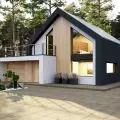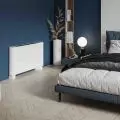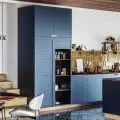At last, summer is here! The warm rays of the sun and the beginning of summer vacation gently transport us to spaces and places where we can relax. Such are also the Hyttee summer houses, which we visited a few years ago as part of the Architecture of Pleasure series. How did their fate turn out? Did they delight tourists in Dubai? We talk with Marlena Kilian about the design of the CLT chalets.
Hyttee 2.0
Photo: Maciej Ławniczak
"How many meters do we need for happiness?" — Tomasz Bogusz of the HAG Human Architecture Group studio asked on A&B, describing his experience of living with his family (2+3) on 27 square meters. The situation changes, of course, depending on whether the metric is for daily living or the base for holiday escapades. With good space organization, according to Jakub Szczęsny, author of many small modular homes, 35 square meters should be enough. This magical limit — which until recently was the limit of the need to apply for permission to build a property — has proven itself in the case of the acclaimed Hyttee summer house by Marlena Kilian and Mark Piojda. After the success of their first project in the Bardzkie Mountains, they designed its next installment — meet Hyttee 2.0.
The hut is planned on a rectangular plan and topped with a gabled roof
Photo: Maciej Ławniczak
Like its little brother, Hyttee 2.0 is meant to promote CLT technology, i.e. using cross-laminated and laminated timber, in which Kilian and Piojda see the future. The minimalist and rather simple building is planned on a rectangular plan (8.8 × 4 meters) and topped with a gabled roof. The wooden facade is broken by the large glazing of a sliding window on the northeast side, which offers a picturesque view of the countryside. The building is surrounded on three sides by a terrace, and a bay window with a parapet-sitting area is located on the northern side. The small block houses a living room with a kitchenette, a bathroom and a mezzanine. Sleeping rooms are located both on the first floor and on the mezzanine.
spacious terrace
Photo: Monika Luniak
The interior is a tribute to nature. The walls of Hyttee 2.0 are a work of nature, where the grains of the CLT panel boards create textures, colors — the authors explain.
Most of the furniture (in the kitchen and bedrooms) was designed and made by Marlena and Marek, others also bear traces of their work — for example, the chrome elements of the sofa designed by Robert Slezak were sanded by Marlena, and the upholstery was sewn by a friendly craftsman.
Most of the furniture (in the kitchen and bedrooms) was designed and made by Marlena and Marek
Photo: Monika Luniak
We talk to Marlena Kilian about the differences between the first and second versions of the house, the expositions where the original was presented, CLT technology and the situation on the house market
Ola Kloc: The mock-up of the Hyttee house was presented at the EXPO 2020 exhibition in Dubai and at the Wrocław Museum of Architecture — how did visitors react to the project?
Marlena Kilian: The small-scale mock-up of the Hyttee house was part of an exhibition entitled "Landscapes of Leisure". It told the story of the relationship between architecture and landscape. The models and photographs depicted leisure places from different regions of Poland and were presented at the end of the World Exhibition in the Polish Pavilion. The exhibition was prepared by the Adam Mickiewicz Institute in cooperation with the Museum of Architecture in Wroclaw. In Dubai, the exhibition was seen by more than 300,000 visitors in just 15 days. In the summer of 2023, the Museum of Architecture presented the exhibition again in Wrocław, where it was also popular with visitors. Among the historic leisure facilities, ours was one of the newest. Hyttee received acclaim, especially its idea striving for sustainable construction. Piotr Sarzynski in the pages of Polityka in an article titled "Home of the Tourist" mentions Hyttee this way:
At the Wroclaw exhibition, the most recent project on display is the small private 2019 Hyttee House, which stood in the Sudetenland outback. It features everything that is important today: natural local materials, energy independence, the promise of tranquility and total detachment from civilization. [...] The complete opposite of herd rest, with which, after all, it has one thing in common — the anticipation of the coveted vacation of the occupants of the "landscapes of rest".
View from the mezzanine and sofa designed by Robert Slezak
Photo: Monika Luniak
Ola: This is the second realization of Hyttee — what changes have you made in version 2.0? What did the original teach you?
Marlena: We treated the first Hyttee project as an experiment. We had not worked with CLT (cross-laminated timber) before, moreover, there were no realizations made of this material in Poland yet. We used information and articles that were available in the Austrian or Canadian press. In the second project, we assumed that we no longer wanted to combine CLT monolith and frame construction, so the ceiling, roof and partition walls were made of CLT panels. This improved the achievement of a closed shell. Another thing that differentiates the two houses is the layout of the rooms, this time we opted to reduce the living area at the expense of separating an enclosed bedroom on the first floor level. A comfortable staircase leads to the mezzanine in Hyttee 2.0, and there is room for a closet underneath.
Minimalist interior of a summer house
Photo: Monika Luniak
Ola: The house is made with CLT technology — what challenges does this type of solution involve?
Marlena: The biggest challenge during the design was to devise a way to divide the panels so that they could be brought using standard transport vehicles. Most of the decisions should also be made at the design stage, since the finished walls are immediately assembled on site, and the construction of such a small building is done in one day. Construction is also a considerable challenge, requiring precision and experience of those installing the panels.
upstairs bedroom
Photo: Monika Luniak
Ola: There has been a lot of talk about the slump in the single-family home market in Poland — last year the number of single-family home construction starts was the lowest in years. How does this look from your perspective?
Marlena: We don't put Hyttee in the category of single-family houses, but holiday homes. However, we observe that after a definite increase in interest in alternatives to traditional construction, we have noticed a decline in inquiries. The initial popularity was linked to pandemonium, the need to escape to nature and the possibility of working remotely. Today, the prices of building materials, including traditional construction, have become significantly more expensive. According to us, people looking for their first home are opting for smaller, more economical solutions, i.e. flats in multifamily buildings. As for the vacation home market, there is a noticeable stagnation, not a decline in interest.
Ola: Thank you for the interview.






























































